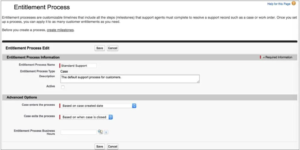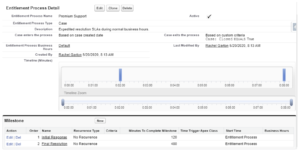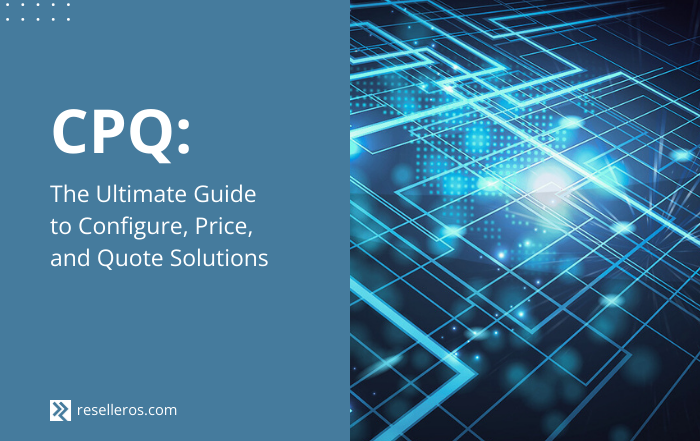What You Can and Can’t Do with Entitlement Management Through Salesforce
In 2021, more than 75% percent of business decision-makers reported that the Covid-19 pandemic has accelerated digital transformation in their companies and elevated the adoption of new technologies to meet evolving customer communication preferences among their priorities. Fortunately, entitlement management features through Salesforce already exist to aid companies in implementing sophisticated customer support solutions.
Today’s customers want to resolve routine issues independently, and the technology to assist them has significantly improved in recent years to make this possible. Chatbots can now reliably resolve two-thirds of customer support issues that do not require an escalation. Nevertheless, there remains a balance between automating simple support tasks to give customers the power to resolve the problems on their own terms and providing human interaction where and when desired.
Salesforce entitlement management gives companies a powerful toolkit to implement effective customer support strategies. In this guide, you’ll get acquainted with entitlement management and how to configure it for your business.
What is Entitlement Management?
As part of its cloud-based customer relationship management (CRM) services, Salesforce includes a set of customer service features designed to ensure that support agents provide customers with appropriate levels of service. In this context, a Salesforce entitlement is a base unit of customer services such as phone or chat support.
Salesforce entitlement management has six features.
- Entitlements: Entitlements tell agents whether customers are eligible for support and enumerate the types of support they are entitled to.
- Entitlement Processes: Processes establish different tiers of support.
- Service Contracts contain relevant customer support agreements such as subscriptions, warranties, and guaranteed maintenance.
- Experience Cloud Entitlements: Experience Cloud offers users a portal to view customer entitlements and contracts by account and initiate cases for them.
- Reporting: This record-keeping feature tracks the use of entitlements and service contracts in your business.
Milestones: Salesforce entitlements can be given milestones that track whether case responses have been initiated and the remaining resolution times.
What Entitlement Management Through Salesforce Does
Salesforce entitlements help businesses standardize and monitor their customer support processes. Depending on the product warranties and service level agreements you offer, your support agents may need to execute multiple tiers of services on various timelines. Without well-defined processes at every stage, agents can be left to guess what steps to take next, and customers may not receive the support you’re obligated to provide them.
Salesforce breaks up managing entitlements into two separately defined parts called Milestones and Processes. Milestones represent when support activities happen. Processes determine which activities happen. Workflow Actions that assist in tracking and prioritizing cases may also be assigned to entitlement Processes through Milestones.
- Milestones
Milestones allow you to manage customer support issues with tiers of time-dependent settings that can be assigned to different processes. In Salesforce, Milestones appear under the Entitlement Management tab. Milestones have three time-to-resolve options.
- No Recurrence will initiate a single countdown when cases are opened.
- Sequential will initiate countdowns at regular intervals until the case is resolved.
- Independent will initiate countdowns at customized junctions such as support responses.
Setting countdowns and recurrence times with Milestones allows you to write support timelines in advance and monitor them live or when countdowns expire.
- Processes
In Salesforce terminology, entitlement Processes are different policy levels you establish for customer support agents to manage cases. Processes are made of individual entitlements – types of support – such as chat, email, or phone support.
When you create a new process, you set its entitlements in four Entitlements Process Edit form fields.
Name: While Salesforce free tutorials use Standard, Platinum, Gold, and Silver for four different service levels, they’re simply shorthand for descriptions, and any names can be used.
Description: Here is where entitlements are enumerated. This allows agents to know precisely which entitlements apply in any case.
Active: Checking this box activates the Process. You can leave new Processes inactive until Milestones are assigned or inactivate Processes to make alterations.
Business Hours: Setting business hours for processes determines when milestone countdowns run.
Entitlement Processes allow you to manage how support resources are allocated for different service obligations.
How Milestones and Processes Combine with Workflow Actions
Entitlements apply in real customer support cases when you assign Milestones to active Processes. Every Process has a details page with a list of set Milestones depicted on a timeline. As you add new Milestones, you can see the timeline develop, suggesting when workflow Actions should be taken.
You can assign three kinds of workflow Actions to Milestones.
- Success Actions indicate the successful completion of Milestones.
- Warning Actions indicate countdowns that will soon expire.
- Violation Actions indicate expired countdowns.
In each case, the Action may take the form of an email alert, the assignment of a new task, or a field update. Assigning workflow Actions helps agents prioritize cases under high volume. It also enables you to measure how effectively your agents maintain services level agreements.
Entitlement Management Limitations
As with other features and applications, Salesforce publishes documentation for entitlement management that includes a list of known internal limitations. Also, as per Salesforce standard practice, this documentation is free but does require an account to view. These limitations mainly relate to how data is passed between internal fields such as sharing and merging, which are restricted for entitlements.
In a less technical context, entitlement management has the potential to suffer from an over-reliance on time-to-resolve metrics like Milestones. Under high volume, agents can find themselves pressured to resolve cases prematurely to avoid the negative consequences of violations. As poor customer service experiences cost US businesses an estimated $62 billion annually, it’s a risk no one can afford to ignore. Mitigating this risk requires fine-tuning the entitlement management process to your specific business needs.
Apply Salesforce with Experience and Expertise
The Salesforce Service Cloud offers businesses a broad array of tools to improve customer relations and support. While these tools scale to business needs of any size, using them smartly and efficiently can prove challenging without the depth of experience to draw upon. At Rainmaker, our team of experts has helped businesses implement Salesforce successfully for more than eight years.
To learn how our experience and expertise can work for you, contact Rainmaker today.









